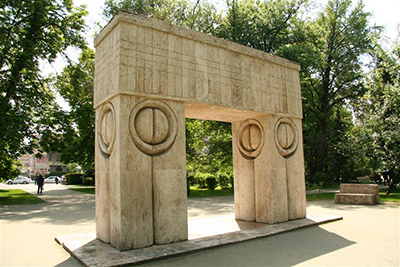Arguably one of Brancusi's most poignant sculptures, this piece was commissioned in 1935 to serve as a memorial to soldiers who defended Târgu Jiu against attack from the Central Powers.
Brancusi refused any payment for this work, and although he resided in Paris at the time, he was willing to travel to his native country and create this work on an unprecedented scale, for an outdoor space. The Gate of the Kiss is part of an ensemble of three sculptures, the others being The Endless Column and The Table of Silence. The commemorative sculptures are orientated from west to east, resembling the direction of sunset through to dawn. Perhaps falling in battle is the evening, whilst waking to eternal life is morning. The kiss gateway is made from Travertine, a neutral coloured marble with a mineral limestone basis.
This sculpture is remarkable not least because of its survival of the Romanian Revolution of 1989 and the fall of the Communist regime. It is a proud testimony to one country's commitment to remembering what will always matter in human terms, irrespective of political priorities. As with so many of Brancusi's sculptures, The Gate of the Kiss is highly ambiguous in its meaning, and much depends on the viewer's personal interpretation. Whatever your view of the kiss itself, an archway, with a destination on either side, is invariably a passage. Given its location, this is almost certainly a transition from one state to another, from death to life, or life to death, depending on your religious perspective.
Love is of course an aspect of life. When soldiers departed for war, they kissed their loved ones farewell. It could be that on the eves of their sacrifice, there was this parting kiss. The motifs on the gateway, with a divided circle on either side and the groove that represents this division extending all the way down to the base of the arch, could be many things. Some see in the two halves a mouth divided by lips. Others see eyes peering at the inside of the gateway, whilst others still are reminded of how the mouths of two people can join. This would be the most literal, given the sculpture's title. In life, there are opening kisses and there are closing kisses. This archway could be both. To walk through an archway is to move one's foot from one side of a stile to another, thus the archway is transition. It has about it an impressive presence; nobody can walk through the gate without being deeply affected.




